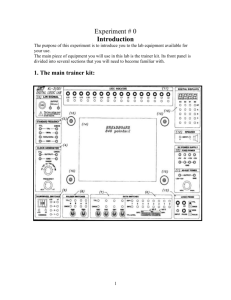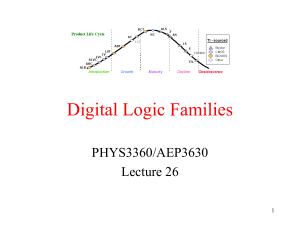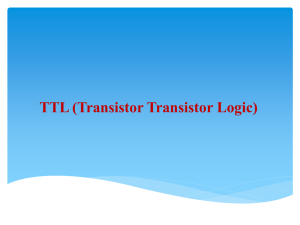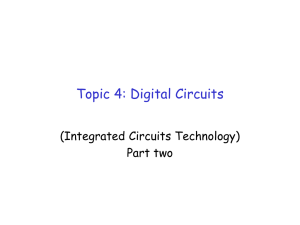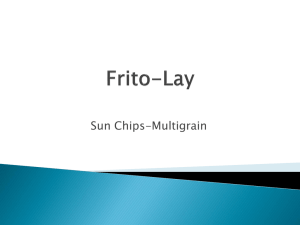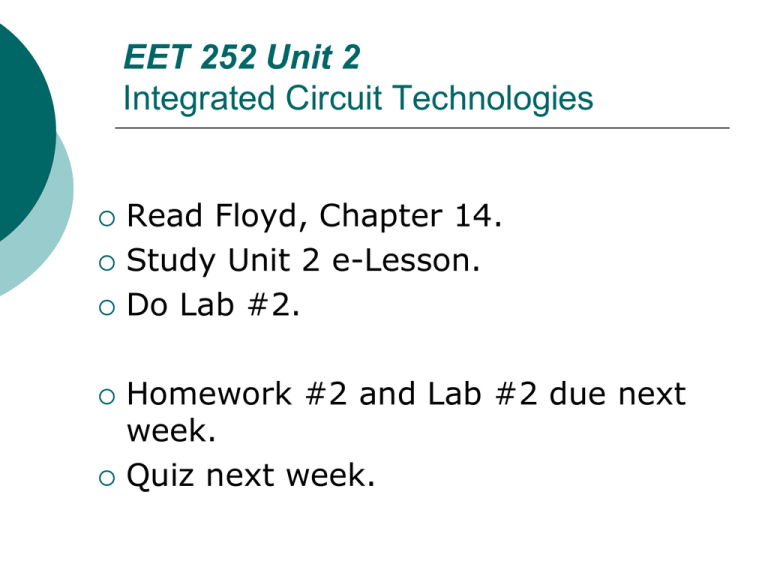
EET 252 Unit 2
Integrated Circuit Technologies
Read Floyd, Chapter 14.
Study Unit 2 e-Lesson.
Do Lab #2.
Homework #2 and Lab #2 due next
week.
Quiz next week.
Two Kinds of Transistors
•In Semiconductor Devices & Circuits (EET 201) you’ll
study two major classes of transistors:
•Bipolar Junction Transistors (BJTs)
•Metal-Oxide Semiconductor Field Effect Transistor
(MOSFETs)
Logic Families
•Two major logic families:
•TTL (Transistor-Transistor Logic) based on bipolar
junction transistors
•CMOS (Complementary Metal Oxide
Semiconductor) based on MOSFETs
•Within each family are several subfamilies: see tables
on page 135.
•Originally, TTL chips were fast but used lots of power,
and CMOS chips used little power but were slow.
•CMOS chips are sensitive to static discharge, and
must be handled carefully.
7400 Series and 4000 Series
•A popular series of TTL chips is the 7400
series that you’ve used in previous courses:
Wikipedia's list
•A popular series of CMOS chips is the 4000
series: Wikipedia's list
•To provide part number and pin number
compatibility with the 7400 series, a later
series of CMOS chips was developed as the
74HC00 series.
Basic Operational Characteristics
and Parameters
Consult datasheets for
DC supply voltage
Logic levels & noise margin
Power dissipation
Propagation delay
Speed-power product
Loading and fan-out
Example datasheets:
7404 TTL inverter
74HC04 CMOS inverter
DC Supply Voltages
TTL chips are optimized for 5 V supply,
and cannot tolerate voltages far above
or below 5 V.
CMOS chips may be optimized for 5 V,
3.3 V, 2.5 V, or 1.8 V supplies. Most
CMOS chips can tolerate a much wider
range of supply voltages than TTL
chips.
(Floyd, p. 770)
Logic Levels
Four key voltage parameters when
you’re interfacing logic:
VIH(min) = the minimum voltage that an
input pin will recognize as a HIGH.
VIL(max) = the maximum voltage an input
pin will recognize as a LOW.
VOH(min) = the minimum voltage that can
appear on a HIGH output pin.
VOL(max) = the maximum voltage that can
appear on a LOW output pin.
Logic levels for TTL
Noise Margin
The noise margin is the room for
error between the voltage that an
output pin produces and the voltage
that an input pin expects.
Typo on p. 773 of Floyd: Equations 14-1
and 14-2 should say:
VNH = VOH(min) − VIH(min)
VNL = VIL(max) − VOL(max)
Power Dissipation
Recall that power equals current times
voltage (P=IV).
So a gate’s power dissipation is given
by its supply voltage (VCC) times its
supply current (ICC).
A lower-power device wastes less
energy, generates less heat, and costs
less to run than a higher-power device.
Propagation Delay
Recall that data sheets specify
propagation delays for low-to-high
transitions (tPLH) and high-to-low
transitions (tPHL).
A device with a smaller propagation
delay can run faster (at a higher
frequency) than a device with a higher
propagation delay.
Speed-Power Product
A useful overall measure of a device’s
performance is its speed-power
product, found by multiplying its
average power dissipation times its
average propagation delay.
The lower the speed-power product,
the better.
Current-Sourcing and CurrentSinking
For TTL:
A HIGH output sources current
A LOW output sinks current.
Figure 14-12 in Floyd
Fan-out
Fan-out means the number of load
inputs that a given output can
drive.
With TTL, current is the limiting
factor in determining fan-out.
With CMOS, capacitance is the
limiting factor.
Calculating TTL Fan-out
For a standard TTL gate:
Also:
A LOW input sources up to 1.6 mA.
A LOW output can sink up to 16 mA.
A HIGH input sinks up to 40 A.
A HIGH output can source up to 400 A.
Thus, standard TTL has a fan-out of
10.
See Wisconsin Online’s Fan-out Lesson
Unused Inputs
Recall that unused inputs should not
be left floating. Either tie them to VCC
through a 1-kΩ resistor or tie them to
ground.
(See Figure 14-45 in Floyd for two
other options.)
Three Kinds of Outputs
TTL chips can have three kinds of
outputs:
Totem-pole (the most common)
Open-collector
Three-state
Totem-Pole Output
Most chips you’ve used up to now
have had totem-pole outputs.
Figure 14.27 A standard TTL inverter circuit.
Digital Fundamentals, Tenth Edition
Thomas L. Floyd
Copyright ©2009 by Pearson Higher Education, Inc.
Upper Saddle River, New Jersey 07458
All rights reserved.
Open-Collector Output
Missing a transistor internally, so
you must provide an external pullup resistor.
Allows for the use of higher-thanusual voltages and currents.
Allows a trick called “wired-AND,”
which means you can AND the
outputs of two chips by tying them
directly together. (Never tie totempole outputs together.)
Figure 14.31 TTL inverter with open-collector output.
Digital Fundamentals, Tenth Edition
Thomas L. Floyd
Copyright ©2009 by Pearson Higher Education, Inc.
Upper Saddle River, New Jersey 07458
All rights reserved.
Figure 14.32 Open-collector symbol in an inverter.
Digital Fundamentals, Tenth Edition
Thomas L. Floyd
Copyright ©2009 by Pearson Higher Education, Inc.
Upper Saddle River, New Jersey 07458
All rights reserved.
Some Open-Collector Chips
7405 (Hex Inverters with Open-Collector
Outputs)
7409 (Quad 2-Input AND with OpenCollector Outputs)
7412 (Triple 3-Input NAND with OpenCollector Outputs)
Three-State Output
In addition to the two usual output
states (HIGH and LOW), has a third
output state called high-impedance
(“high-Z”).
In the high-Z state, the output is
disconnected from the external
circuit.
Useful when the outputs of many
chips are tied to the same bus: at
any time, only one of them should
be connected to the bus.
Figure 14.22 The three states of a tristate circuit.
Digital Fundamentals, Tenth Edition
Thomas L. Floyd
Copyright ©2009 by Pearson Higher Education, Inc.
Upper Saddle River, New Jersey 07458
All rights reserved.
Figure 14.33 Basic tristate inverter circuit.
Digital Fundamentals, Tenth Edition
Thomas L. Floyd
Copyright ©2009 by Pearson Higher Education, Inc.
Upper Saddle River, New Jersey 07458
All rights reserved.
Some Three-State Chips
74251 (Data Selectors/Multiplexers with 3State Outputs)
74LS295 (4-Bit Right-Shift Left-Shift
Registers With 3-State Outputs)
74LS348 (8-Line To 3-Line Priority
Encoders With 3-State Outputs)
Figure 14.17 A CMOS inverter circuit.
Digital Fundamentals, Tenth Edition
Thomas L. Floyd
Copyright ©2009 by Pearson Higher Education, Inc.
Upper Saddle River, New Jersey 07458
All rights reserved.
Three Kinds of CMOS Outputs
Like TTL chips, CMOS chips can
have two kinds of special-purpose
outputs instead of the usual
outputs:
Open-drain
Similar to open-collector in TTL
Requires an external pull-up resistor
Three-state
Other Logic Families
•ECL (Emitter-Coupled Logic): The fastest logic family
•PMOS (p-Channel MOS)
•NMOS (n-Channel MOS)
•E2CMOS (Electrically Erasable CMOS)

